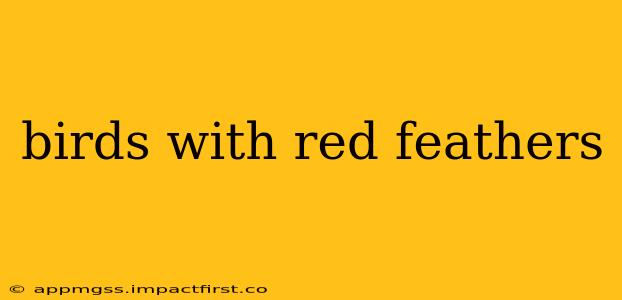The vibrant flash of red feathers in the natural world is captivating. Many bird species boast this striking coloration, achieved through various pigments and structural adaptations. From the fiery brilliance of cardinals to the subtle crimson hints on smaller birds, the presence of red feathers often signals a unique role within their ecosystem, be it attracting mates, warning predators, or camouflaging in specific environments. This comprehensive guide delves into the diverse world of birds with red feathers, exploring the reasons behind their coloration and showcasing some of the most remarkable examples.
Why Do Some Birds Have Red Feathers?
The striking red color in bird plumage isn't merely aesthetic; it serves vital functions. The vibrant hues are primarily generated by two mechanisms:
-
Carotenoids: These pigments, obtained through diet, are responsible for many shades of red, orange, and yellow. Birds ingest carotenoids from fruits, insects, and other food sources, then metabolize and deposit them in their feathers. The intensity of the red coloration often reflects the bird's diet and overall health, making it an honest signal of quality to potential mates.
-
Psittacofulvins: These pigments, unique to parrots and some other species, produce reds and yellows. Unlike carotenoids, psittacofulvins are produced within the bird's body, independent of diet.
Furthermore, the structure of feathers themselves can influence the appearance of red. Microscopic structures within the feather barbules can diffract light, creating iridescent effects that enhance the red coloration and produce shimmering displays.
What are Some Examples of Birds with Red Feathers?
Numerous bird species exhibit red feathers, ranging from entirely red plumage to subtle accents. Here are some notable examples:
-
Northern Cardinal (Cardinalis cardinalis): A classic example, the male Northern Cardinal is renowned for its bright crimson plumage, a striking feature used in mate attraction and territorial defense.
-
Scarlet Tanager (Piranga olivacea): This migratory songbird displays a stunning contrast, with a vibrant scarlet body and black wings and tail. Females have a more subdued olive-green and yellow coloration.
-
Summer Tanager (Piranga rubra): Similar to the Scarlet Tanager, the Summer Tanager boasts a bright red body. The males are entirely crimson, while females are a yellowish-orange.
-
Red-bellied Woodpecker (Melanerpes carolinus): Although its name might suggest otherwise, the red coloration on this woodpecker is restricted to a band on its head and belly.
-
Red-breasted Sapsucker (Sphyrapicus ruber): This woodpecker exhibits a striking red patch on its breast, a key identifying feature.
-
Vermilion Flycatcher (Pyrocephalus obscurus): This small, striking flycatcher showcases a bright vermilion red breast and head in the male, with females displaying a duller orange-yellow.
What Birds Have Mostly Red Feathers?
While many birds incorporate red feathers as accents, fewer species are predominantly red. The Northern Cardinal, Scarlet Tanager, and Summer Tanager stand out as birds with predominantly red plumage in their adult male forms. It’s important to remember that the coloration often varies between sexes, with females generally displaying less vibrant or different colors.
What is the Meaning of Red Feathers in Birds?
The significance of red feathers often relates to:
-
Sexual Selection: Bright red plumage is frequently used to attract mates. Males with more intense red coloration often have greater reproductive success.
-
Territorial Defense: The conspicuous red can act as a warning signal to rivals, helping to establish and defend territories.
-
Camouflage: In some cases, red feathers can provide camouflage within specific environments. For example, some birds with red feathers might blend effectively with flowering plants or reddish soil.
-
Aposematism: Some birds with red feathers are poisonous or unpalatable. The bright red coloration serves as a warning signal to potential predators.
Are There Any Birds with Completely Red Feathers?
While no bird species is completely uniform in its red coloration across every feather, some, like the male Summer Tanager in its breeding plumage, come very close. The intensity and precise shade can vary slightly depending on factors like diet and individual variation.
This exploration showcases the fascinating diversity and significance of red feathers in the avian world. The vibrant colors are a testament to the intricate interplay between genetics, diet, and the pressures of natural selection. By understanding the underlying mechanisms and ecological roles of red plumage, we gain a deeper appreciation for the beauty and complexity of these remarkable creatures.
